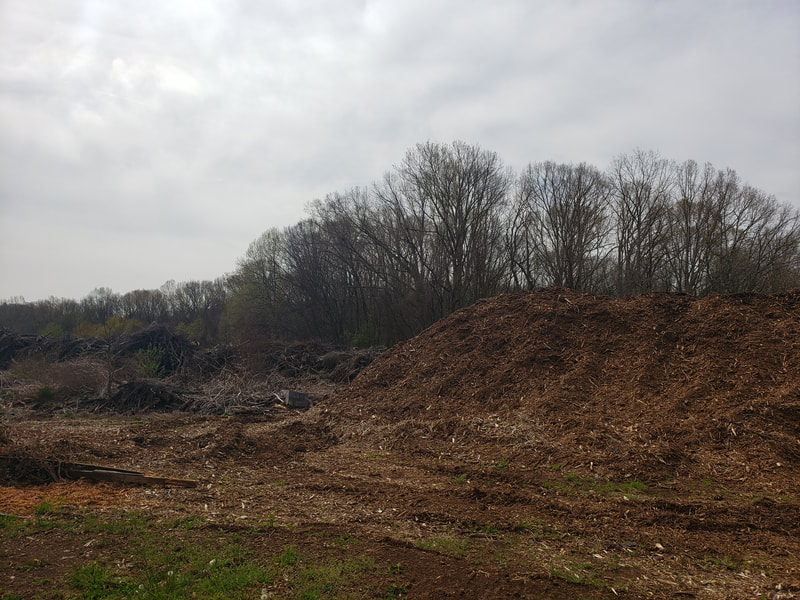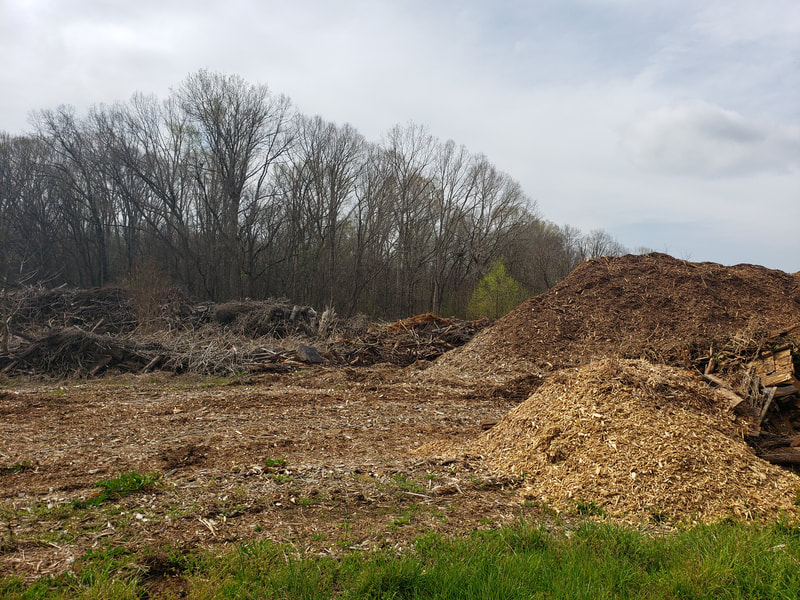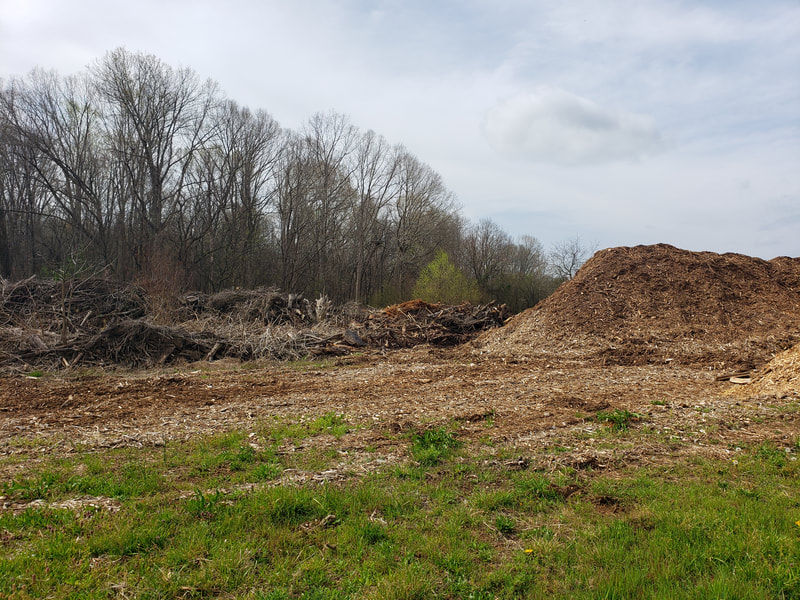While an arborist certainly does these things, he also does much more, including lightning protection, cabling and support for larger trees that stand alone, disease and insect identification and treatment, aeration and root excavation, and planting and establishment.
That being said, periodically, my daily walk takes me by his place of business, which consumes more than seventeen acres altogether. Here, in addition to various structures and places for equipment storage and parking, he also has large tracts set aside for storing tree-cutting debris.
At the end of each day, when his trucks come back in, they are generally loaded with the residue of a hard day’s work. Upon arrival, large crane-type appendages are used to offload the remains of tree trunks, limbs, branches, and the like. These are then placed atop piles of previously accumulated detritus that usually climb to a height of around fifteen to twenty feet. These successive piles wind up in rows that can easily run twenty feet across and over a hundred yards long.
But they are not destined to remain there long. On a regular basis, equipment is brought in that then pulverizes these piles of tree remains into wood chips. In turn, this pulp is collected in mounds and stored until it is loaded and taken to places where it can be processed for lumber, wood products, etc…
All in all, it’s a pretty good system – one that benefits the customer, the arborist, his employees, and yes, even the environment. And looking at the amount of wood he processes, as well as the level of business he undertakes, both the man and his employees obviously do very good work!
In fact, from all appearances, only one single entity appears to find the whole enterprise objectionable. And just who is that? Very likely it is the group of large trees situated on neighboring property adjacent to that of the arborist that happens to tower over and look down upon the disconcerting scene described above.
Now, if trees can be said to feel and see and hear and perhaps even to think, then these trees must surely look down on what all is unfolding beneath them with some degree of distress. And if such were to be the case, is it not reasonable to assume that they might worry over whether this might be their own ultimate ending?
Is it their destiny one day to be struck down and wind up on this (or some similar) debris pile awaiting inevitable annihilation in the hardened steel teeth of some diesel driven chipper? One has to wonder if they have any inkling of their own impending demise!
To make all of this relevant, the French are said to have a saying: “It is the fate of all glass to be broken!” If this is so, then it is surely the fate of all trees, no matter how tall and/or majestic they may be, to fall. And when they eventually do come down, either mankind or nature herself will surely be there to process their remains into oblivion.
All glass eventually breaks; all trees eventually fall down; and yes, all men and women eventually die. Like everything else in this world that draws breath, that is our fate! But alone among God's creatures, we face more than mere physical death. As the Bible says (in the New Testament Book of Hebrews, chapter 9, verse 27): “… it is appointed for men once to die, and after this to face judgment…”
How true this verse is! We all know our earthly life will one day come to an end. This is inevitable; as is some manner of afterlife. Biblically, after death, we will all face the judgement of God. And from there, we will spend eternity either in Heaven or in Hell.
And all of this brings me to my point. As I post this, it is Good Friday. This is the day on which believers commemorate the sacrificial death of Jesus Christ. While completely innocent Himself, Jesus nonetheless chose to die on the cross as a propitiation for the sins of men and women in every time and place in all of history. In so doing, He literally paid the price for our sins.
Therefore, as Billy Graham once put it, our sins will not send us to Hell. Jesus dealt with our sins. What determines our eternal destiny, therefore, is what we do with Jesus Christ. Will we, as individuals, accept His sacrifice on our behalf and submit to Him as Lord and Savior? Or will we reject His gracious offer of salvation?
Easter shows us that Jesus proved that He is exactly Who He claimed to be. As the Son of God, He overcame death, the grave, and even Hell itself. And because of this, we do not have to fear our own death! Nor do we have to fear our eternal destiny! We can be confident that when our time in this world comes to an end, we will find life afresh and life anew in yet another and far better world – one where we will have nothing whatsoever to fear.
For there, in that world, we will never again be destined to die! There, in that world, we will live forever in God’s presence. There, in that world, we will be made full and majestic and perfect as we finally embody all the glory God intends for us! There, in that world, we will stand tall for all eternity! And there, in that world, we will never have need or have opportunity to ponder any other destiny!
Amen!
SOURCES: The conscientious arborist I am referring to is Mr. Ben Hazel at Prees Trees. Cf.: https://preestrees.com/.
SCRIPTURE: https://biblehub.com/hebrews/9-27.htm.
NOTE: My post title, "Fear Not!", is the phrase most often associated with the angel's announcement to the shepherds at Jesus' birth as recorded in Luke chapter 2, and celebrated at Christmas. What happens at Easter, however, only serves to confirm the veracity of that angelic pronouncement!


